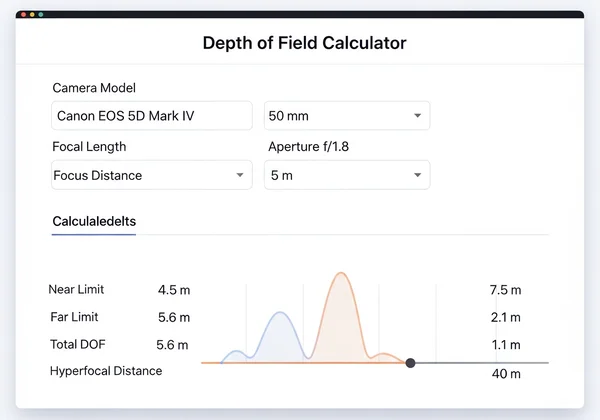DOF Calculator Troubleshooting: Solve Common Depth of Field Problems
Struggling with blurry backgrounds or landscapes that lack crispness? You've encountered depth of field problems, a common hurdle in photography. Mastering Depth of Field (DOF) is key to unlocking creative control and professional results. But what is depth of field in photography, and how can you command it?
This guide diagnoses common DOF and focus issues, explaining their causes and solutions. We'll show you how our intuitive DOF Calculator is the secret to planning and executing perfect shots every time.

Why Isn't My Background Blurry Enough? Mastering Shallow DOF
A common frustration for photographers is failing to achieve a dreamy, out-of-focus background, or "bokeh." If your subject blends into a busy background, your depth of field is too deep. Let's explore how to fix this and create a shallow DOF.
Understanding Aperture, Focal Length, and Subject Distance for Bokeh
Creating a shallow depth of field depends on three critical factors. Getting one wrong can ruin the effect.
- Wide Aperture (Low f-number): Aperture is the opening in your lens that lets light in. A wider aperture (e.g., f/1.8, f/2.8) dramatically reduces the depth of field, isolating your subject by blurring the background. This is the most significant factor.
- Longer Focal Length: A telephoto lens (e.g., 85mm, 135mm, 200mm) compresses the background and enhances the blur, making it appear much shallower than a wide-angle lens at the same aperture.
- Proximity to Subject: The closer you are to your subject, the shallower your depth of field becomes. Simultaneously, increasing the distance between your subject and the background will further intensify the blur.
Mastering the interplay of these three elements is crucial. Before your next shoot, you can simulate these changes and calculate depth of field to see exactly how your settings will perform.

Does My Camera Sensor Affect Background Blur? Crop vs. Full-Frame
Yes, sensor size matters. A full-frame sensor produces a shallower DOF than a crop sensor (APS-C, Micro Four Thirds) with the same effective focal length and aperture. To get the same field of view on a crop sensor, you must use a wider lens or stand further back—both actions increase depth of field. This is why pros favor full-frame cameras for portraits. Our tool functions as a crop sensor calculator, letting you select your camera model to see how its sensor impacts the result.
Using the DOF Calculator for Perfect Portrait Backgrounds
Stop guessing and start planning. Instead of endless test shots, use our powerful dof simulator to visualize the outcome. For example, planning a portrait with an 85mm f/1.8 lens? Input your camera model, focal length, and aperture into the DOF Calculator. By adjusting the focus distance, you'll see in real-time how the sharp zone changes, allowing you to precisely position your subject for that perfect, buttery background.
Getting Everything in Focus: Solving Deep DOF Challenges
Conversely, in landscape or architectural photography, the goal is maximum sharpness from the foreground to distant mountains. If parts of your landscape shots are soft, your depth of field is too shallow. The solution is to create a deep DOF.
Hyperfocal Distance Explained: Achieving Front-to-Back Sharpness
The secret to ultimate sharpness is the hyperfocal distance: a specific focus point that maximizes your depth of field, keeping everything from a certain point to infinity acceptably sharp. Guessing this is nearly impossible. When you focus at the hyperfocal distance, your DOF extends from half of that distance to infinity. For instance, with a hyperfocal distance of 10 feet, everything from 5 feet to the horizon will be in focus. This is the technique pros use for breathtakingly sharp landscapes.

How Lens Choice and Focal Length Influence Deep Field of view
Just as certain settings create blur, others create sharpness. To achieve a deep depth of field, you need to reverse the principles of bokeh.
- Narrow Aperture (High f-number): Using an aperture like f/11, f/16, or even f/22 will significantly increase the area of focus in your image.
- Wider Focal Length: Wide-angle lenses (e.g., 16mm, 24mm) naturally have a much deeper depth of field than telephoto lenses, making them ideal for landscapes.
Combining a wide-angle lens with a narrow aperture is the foundation for a sharp landscape photo. However, the final piece of the puzzle is knowing exactly where to focus, which is where a hyperfocal distance calculator becomes essential.
Planning Wide-Angle Landscape Shots with the DOF Calculator
Don't leave your epic landscape shots to chance. Our calculator is designed to give you the precise hyperfocal distance you need.
Enter your camera, wide-angle focal length (like 20mm), and desired aperture (like f/11) into our online tool. The results will instantly show you the hyperfocal distance. By focusing your lens at that exact distance, you guarantee the maximum possible sharpness throughout your scene, ensuring your final image is stunningly crisp from front to back.
Beyond DOF: Unmasking Other Common Photography Focus Issues
Sometimes, a soft image isn't a depth of field problem. If you've planned your DOF perfectly but your photos still aren't sharp, investigate these other common culprits behind photography focus issues.
Motion Blur vs. Out-of-Focus: Diagnosing the True Problem
A soft image isn't always a DOF issue. Motion blur occurs when either the subject moves or the camera moves during the exposure, creating streaks or ghosting. This is controlled by shutter speed. If you see directional blurring, your shutter speed was likely too slow. An out-of-focus image, however, will have soft, rounded edges and is purely a focusing error.

The Crucial Role of Accurate Autofocus and Calibration
Modern cameras have incredible autofocus systems, but they aren't infallible. Your camera's AF might be locking onto the wrong object, or your lens may have a front-focus or back-focus issue, where it consistently focuses slightly in front of or behind your target. Performing a lens calibration can often resolve these hidden equipment-related problems.
Is Your Technique to Blame? Camera Shake and Holding Steady
Even with the right settings, poor technique can ruin a shot. Camera shake, caused by unsteady hands, is a major cause of softness, especially at slower shutter speeds. Always use a firm grip, brace your elbows against your body, and gently squeeze the shutter button. For maximum sharpness, especially in landscape photography, nothing beats a sturdy tripod. By eliminating these other variables, you can be sure you are truly tackling your depth of field goals.
Your Path to Mastering Depth of Field and Sharper Photography
Mastering depth of field is not about memorizing charts or complex formulas. It's about understanding the core principles and having the right tools to apply them. By diagnosing whether you need a shallow or deep DOF and planning your settings accordingly, you can transform your photography from simple snapshots into intentional, impactful art.
Stop letting focus frustrations hold you back. The next time you plan a shoot, make the first step a visit to our homepage. Experiment with different settings, visualize the results, and find the perfect parameters for your vision.
Take control of your focus today. Visit the DOF Calculator and start planning your sharpest, most beautiful photos yet.
Common Questions About Depth of Field and Focus Troubleshooting
What Exactly is Depth of Field (DOF) in Photography?
Depth of Field (DOF) refers to the range of distance in a photograph that appears acceptably sharp. A "shallow" or "small" DOF means only a narrow slice of the image is in focus (ideal for portraits), while a "deep" or "large" DOF means a much wider range is sharp, from the near foreground to the distant background (ideal for landscapes).
How Can a DOF Calculator Help Me Fix My Focus Problems?
A DOF calculator removes the guesswork. It allows you to enter your exact camera settings (camera type, focal length, aperture, focus distance) and instantly see the results. It can tell you the precise near focus limit, far focus limit, and total depth of field, and even calculate the hyperfocal distance. This lets you plan ahead to either perfectly blur a background or ensure an entire scene is sharp, solving your focus problems before they happen. You can try our free tool to see it in action.
What is the Circle of Confusion, and Why Do I Need to Know About It?
The Circle of Confusion (CoC) is a technical term for the largest blurred point that a human eye will still perceive as sharp. This value is tied to your camera's sensor size and is a key variable in all DOF calculations. While the concept is complex, you don't need to be an expert. Our calculator automatically uses the correct CoC when you select your camera model, ensuring your results are accurate and tailored to your specific gear.
I'm Still Having Trouble with Focus; What's My Next Step?
If you've used a calculator to plan your DOF and ruled out issues like motion blur and camera shake, your next step should be to test your equipment. Check your lens's autofocus accuracy using a focus calibration chart. Sometimes a lens needs a simple micro-adjustment within the camera's menu to be perfectly sharp. If the problem persists, it may be time to have your equipment professionally serviced.